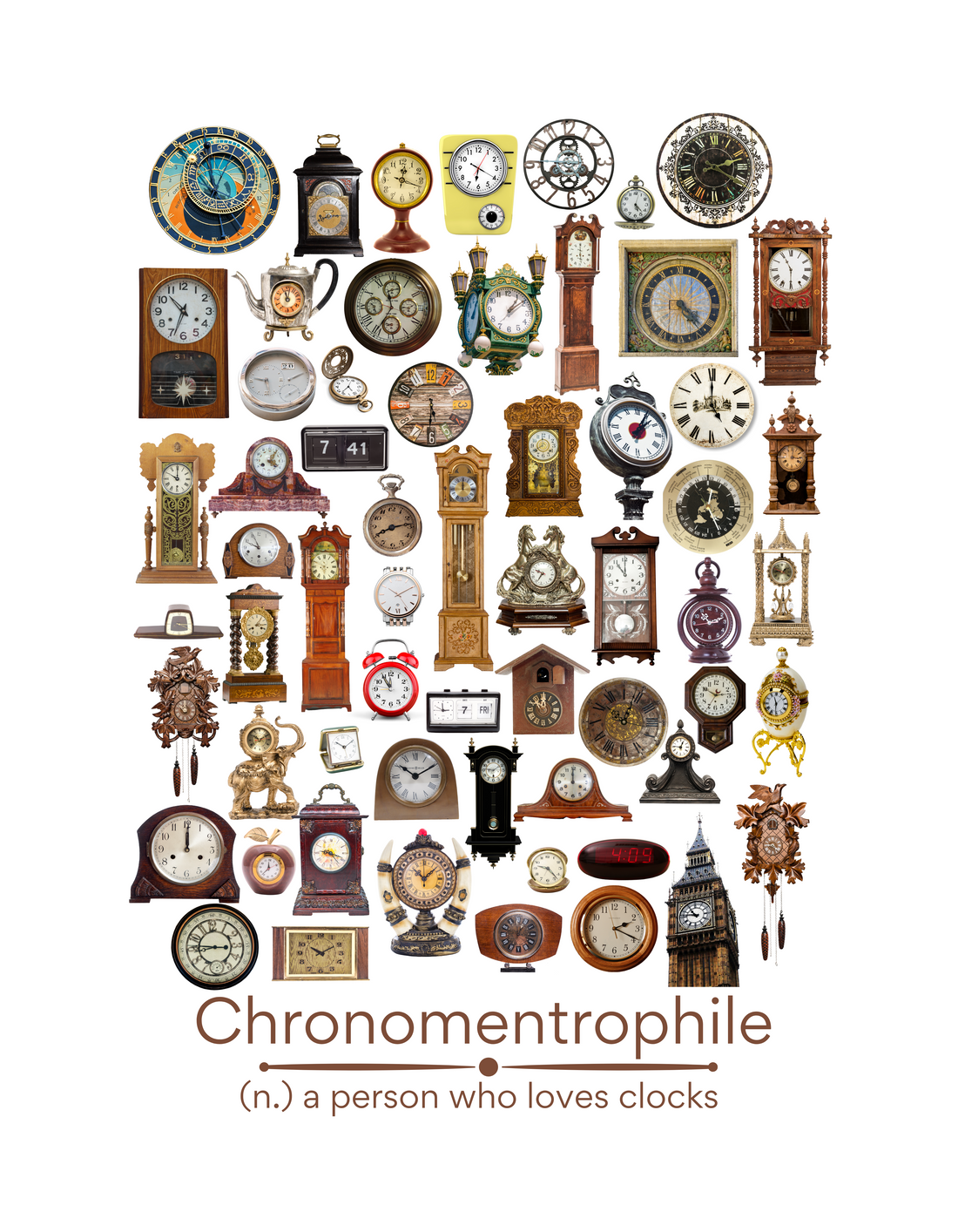
Ticking Through Time: Confessions of a Chronomentrophile
Share
Hickory dickory dock, there’s something magical about the rhythm of a well-made clock. Not just the steady beat that marks time’s passage, but the craftsmanship, the innovation, and the soul embedded in every cog and pendulum.
For many, the fascination with clocks goes back to the womb, with Mother’s heartbeat serving as their first soothing and rhythmic time-keeping instrument. Judging by how popular our “Chronomentrophile” design has become (from toddlers to retirees who once ran their own horology shops), this is a quite common fascination.
So let us take you on a little journey—through history, through oddities, and through some tick-tocking trivia that might just make you fall in love with clocks too.
A Brief History of Clocks (And Why It’s Anything But Boring)
Before we had watches on our wrists or smartphones in our pockets, humans turned to the heavens and the elements to track time. The first "clocks" were actually obelisks (c. 3500 BCS) and then sundials (c. 1500 BCE) in ancient Egypt. These were certainly clever, but only worked on sunny days (and let’s face it, not ideal for our Pacific Northwestweather).
By the 14th century, mechanical tower clocks began popping up in European cities, driven by weights. These were large installations, typically appearing in places like town squares and cathedrals. These early giants didn’t have faces—just bells that rang out the hour, hence the term “clock” from the Latin clocca, meaning bell. The oldest working mechanical clock is the Salisbury Cathedral Clock, dating back to 1386.
Fast forward to the 17th century, and things got a whole lot more precise thanks to Dutch scientist Christiaan Huygens and his invention of the pendulum clock in 1656. It was accurate to within seconds per day—a revolutionary leap. By the 18th and 19th centuries, clocks became status symbols in homes, evolving into intricate longcase (or “grandfather”) clocks, ornate mantle clocks, and whimsical novelty timepieces.
Rare and Remarkable Clocks
Every serious clock collector dreams of stumbling across a unicorn—a timepiece so rare or unusual it stops you in your tracks. Here are a few of the standouts in horological history:
-
The Antikythera Mechanism – Found in a shipwreck off the Greek island of Antikythera in 1901, this 2,000-year-old device is considered the world’s first analog computer. Believed to have been created as far back as around 204 BCE, it tracked celestial bodies and eclipses, and its complexity wasn't matched again for a thousand years.
-
The Atmos Clock (Jaeger-LeCoultre) – This clock runs for an unlimited amount of time on changes in air pressure and temperature. No winding, no batteries. Just brilliant engineering. It's like having a little barometer that tells the time.
-
The Congreve Rolling Ball Clock – Instead of a pendulum, it uses a rolling ball on a zig-zag track to measure time. Beautiful, mesmerizing—and wildly inaccurate. A perfect example of art trumping utility.
-
The Strasbourg Astronomical Clock – Housed in Strasbourg Cathedral, this 18-meter marvel dates to the 16th century and tracks planetary motion, leap years, equinoxes, and more. It even has a mechanical rooster that crows.
Clocks That Make You Go “Huh?”
Some clocks are just... different. And we love them all the more for it:
-
Kit-Cat Clocks – Yes, the ones with the wagging tail and rolling eyes. An American icon since 1932. They’re silly, but try not to smile when one’s ticking on your kitchen wall.
-
Water Clocks (Clepsydra) – Used in ancient China, Babylon, and Greece. These devices measured time by the steady flow of water. Some even chimed and moved figures on the hour—ancient automation!
-
Cuckoo Clocks – Originating in the Black Forest of Germany, they blend folk art with functionality. Early versions were powered by pinecone weights and featured charming hand-carved birds and dancers.
Tick-Tock Tidbits
Here are a few clock related facts for your next dinner party or design inspiration session:
-
A "horologist" is a person who makes or repairs clocks, but a "chronomentrophile" is one who loves them. We’re the romantics in the world of timekeeping.
-
The most expensive clock ever sold? A Patek Philippe Sotheby wristwatch, auctioned for $31 million in 2019. Dubbed the ‘most complicated wristwatch ever made.’
-
In Japan, there's a temple clock that changes its ticking pace to match the shifting length of days throughout the year—proving time is not just mechanical but natural. The Myriad Year clock was designed in 1850 by Tanaka Hisashige. It is also known as a wadokei, an early traditional Japanese clock.
-
In Pink Floyd’s song “Time” off of the album “Dark Side of The Moon,” each clock at the beginning of the song was recorded separately in an antiques store.
Why We Love Timekeepers
Time is one of the few things we all share. Maybe that’s why our Chronomentrophile design has resonated with such a broad audience. Whether you're a retired clockmaker who can still smell the brass oil on your hands, or a toddler who just likes the funny noise the cuckoo makes, the joy of clocks is universal.
They’re more than machines. They’re storytellers. They remember when a house was built, when a wedding was celebrated, when a child was born. They quietly tick through our lives, anchoring us in a world that moves just a bit too fast.
So here’s to the lovers of time—past, present, and future. Whether you wear it on your wrist, display it on your mantel, or sport them proudly on a sweatshirt, you’re in good company.
Tick on, friends.
🕰️
— The Clock Collectors at www.edmonds.love
